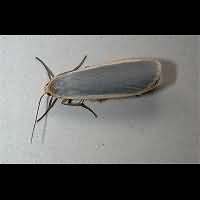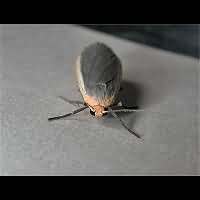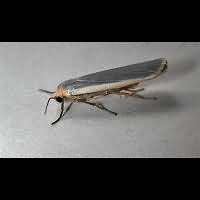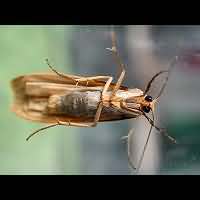Common Footman (Eilema lurideola)
The Common Footman is similar to a number of other Footmen: de frontwing is leaden grey showing an orange edge. Except for the orange head the body is leaden grey too. The hindwings are yellowish. You may confuse him with the female of the Buff Footman and with the Dingy Footman and the Scarce Footman. Yet it isn't very difficult to tell them apart, usually. In the female of the Buff Footman not only the head is orange, but the entire body, including the part visible between the wings behind the head. In all other species the head is orange, but the rest of the body is grey. The orange edge of the wing remains equally broad in the Scarce Footman, while in the Common Footman it tapers towards the tip of the wing. The Dingy Footman is slightly different in shape and has greyish hindwings. But be aware of very worn animals. It can be very hard identifying them. Wingspan of the Common Footman some 31 to 39 mm.
The eggs are being laid in summer and most will hatch in August. The young caterpillars of the Common Footman do eat, but not a lot and they don't grow very fast during this stage. The still very small larvae overwinter sitting on bark or in lyches, not taking any apparent precautions against winter. In April they become active again, start eating again and now grow rapidly. From May or June they'll pupate. They'll spin a cocoon, usually in a crevice of bark, where pupation takes 4 to 6 weeks. The caterpillars themselves are not very big and easily identified: look for a hairy, brownish black caterpillar with a big, orange, interrupted line on the sides and a very thin whittish dorsal line. It will reach a length of 22 to 26 mm tops. It feeds on lyches and mosses on tree trunks, rocks, walls, fences etc. It accepts certain leaves when captured.
The Common Footman is single brooded and is on the wing in July and the beginning of August mainly. Regularly flies by day. By day it also visits flowers, including those in gardens, to suck nectar. Is also seen sunbasking on leaves. This is an easily disturbed and often itchy species, often not easy to photograph. Comes to light happily. Widespread throughout England, Wales and Ireland, local in Southern Scotland. Wherever it appears, it might be in very great numbers. In other parts of Europe very common too, but not in the Far North.
The Common Footman is similar to a number of other Footmen: de frontwing is leaden grey showing an orange edge. Except for the orange head the body is leaden grey too. The hindwings are yellowish. You may confuse him with the female of the Buff Footman and with the Dingy Footman and the Scarce Footman. Yet it isn't very difficult to tell them apart, usually. In the female of the Buff Footman not only the head is orange, but the entire body, including the part visible between the wings behind the head. In all other species the head is orange, but the rest of the body is grey. The orange edge of the wing remains equally broad in the Scarce Footman, while in the Common Footman it tapers towards the tip of the wing. The Dingy Footman is slightly different in shape and has greyish hindwings. But be aware of very worn animals. It can be very hard identifying them. Wingspan of the Common Footman some 31 to 39 mm.
The eggs are being laid in summer and most will hatch in August. The young caterpillars of the Common Footman do eat, but not a lot and they don't grow very fast during this stage. The still very small larvae overwinter sitting on bark or in lyches, not taking any apparent precautions against winter. In April they become active again, start eating again and now grow rapidly. From May or June they'll pupate. They'll spin a cocoon, usually in a crevice of bark, where pupation takes 4 to 6 weeks. The caterpillars themselves are not very big and easily identified: look for a hairy, brownish black caterpillar with a big, orange, interrupted line on the sides and a very thin whittish dorsal line. It will reach a length of 22 to 26 mm tops. It feeds on lyches and mosses on tree trunks, rocks, walls, fences etc. It accepts certain leaves when captured.
The Common Footman is single brooded and is on the wing in July and the beginning of August mainly. Regularly flies by day. By day it also visits flowers, including those in gardens, to suck nectar. Is also seen sunbasking on leaves. This is an easily disturbed and often itchy species, often not easy to photograph. Comes to light happily. Widespread throughout England, Wales and Ireland, local in Southern Scotland. Wherever it appears, it might be in very great numbers. In other parts of Europe very common too, but not in the Far North.







